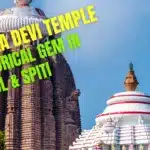Kangra Fort located amidst the breathtaking landscapes of the Kangra Valley in Himachal Pradesh stands as a testament to India’s rich heritage, history, and architectural marvel. This imposing fortress has witnessed centuries of glory, battles, and cultural transitions. In this article, we will delve into the fascinating history, intricate architecture, and the treasures that make the majestic fort in Kangra a true emblem of India’s past.
Unveiling the Past: Kangra Fort History
Perched majestically to the southwest of the ancient town of Kangra, the imposing stronghold known as Nagarkot or Kot Kangra crowns the precipitous hill, overlooking the confluence of the Banganga and Patalganga rivers. This unique topography bestows upon the fort a natural moat, as the two rivers encircle it in a protective embrace. Tracing its roots deep into antiquity, the fort’s earliest remnants are embodied by the Jaina and Brahmanical temples contained within, a testament to the craftsmanship of a bygone era, dating back to approximately the ninth and tenth centuries A.D.
Across the annals of history, the fort’s significance resonates with tales of resilience and conquest, its narrative interwoven with the echoes of Mahmud Ghazni’s invasions in A.D. 1009. The echoes of time reverberate further with its capture by the hands of Muhammad Tughluq and his successor Firuz Shah Tughluq in the years A.D. 1337 and A.D. 1351 respectively.
The Kingdom of Trigarta
Kangra, once the heart of the ‘Trigatra’ realm under the rule of Raja Bhum Chand, held an aura of grandeur as it stood sentinel over the Banganga and Manjhi rivers. This regal capital beckoned Mahmud Gaznavi during his fourth Indian campaign in A.D. 1009, drawn by the allure of its storied riches. The monumental edifices that once challenged monarchs have gradually yielded to the ravages of time, particularly accentuated by the seismic upheaval of 1905.
Architectural Marvel of Kangra Fort
The grand entrance to the fort, guarded by the sturdy Ranjit Singh Gate, offers a glimpse into the architectural prowess of its creators. Crafted from robust wooden planks and ensconced within a sandstone arch, this entrance stands as a testament to the fort’s erstwhile glory. Notably, a moat, hewn into the rocky terrain, unites the Banganga and Manjhi rivers, standing as a natural barrier that separates the fort from the expanse beyond its walls.
Fusion of Styles
The architectural grandeur of Kangra Fort is a fusion of styles, blending Rajput and Mughal influences. The fort complex is a symphony of ornate gateways, delicate carvings, and majestic palaces. The Sheesh Mahal, adorned with intricate mirror work, and the stunning Banganga Temple within the fort premises are just a glimpse of the architectural gems waiting to be explored.
A Glimpse into the Past: Museum Treasures
Kangra Fort houses a museum that meticulously preserves the heritage of the region. Ancient artifacts, sculptures, and relics provide a captivating insight into the cultural evolution of Kangra. The museum is a treasure trove of history, offering a chance to connect with the past and appreciate the artistic finesse of bygone eras.
Entrance Fee and Timings
The fort remains open from 9 am to 5 pm. The entrance fee for visiting Kangra Fort is as follows :-
Citizens of India – Rs 25
Visitors from SAARC – Rs 25 ((Bangladesh, Nepal, Bhutan, Sri Lanka, Pakistan, Maldives and Afghanistan)
Visitors from BIMSTEC – Rs 25 (Bangladesh, Nepal, Bhutan, Sri Lanka, Thailand and Myanmar)
Visitors from Other Countries – Rs 300
(Free entry to children up to 15 years)
Spiritual Resonance of Kangra Devi Mandir
Adjacent to the fort lies the revered Kangra Devi Mandir, also known as Shree Bajreshwari Mata Mandir. This sacred temple draws devotees seeking blessings from the divine. The Shree Bajreshwari (or Vajreshwari Mata Mandir or Kangra Devi Mandir) is one of the 51 Shakti Pithas dedicated to the goddess Vajreshvari, a form of Goddess Durga. The tranquil ambience and architectural beauty of the temple provide a serene contrast to the fort’s formidable presence.
Weather in Kangra
Kangra experiences a medley of captivating weather conditions across its seasons, each contributing to the region’s unique charm. As winter embraces the land, Kangra transforms into a frosty wonderland. From November to February, temperatures often dip to chilly lows, and the surrounding landscapes are occasionally adorned with a blanket of snow, creating a postcard-worthy scene. This period beckons travelers to savor the warmth of crackling fires and indulge in cozy moments. In every season, Kangra unveils a facet of its character, promising an immersive experience that resonates with its ever-changing weather patterns. Whether blanketed in snow, blooming with life, or drenched in rain, each season contributes to the enchantment that defines this charming destination.
Exploring Places of Interest Nearby
The allure of Kangra Fort extends beyond its walls, with nearby attractions that captivate the senses. Dharamsala and Kangra are tourist one of the top tourist destinations in Himachal Pradesh. While you are here there are many interesting places to visit and explore. Some of the popular places for tourists would be as follows :-
Chamunda Devi Temple
Situated on the banks of the Ban Ganga River, Chamunda Devi Temple is a spiritual haven. Devotees are drawn to this sacred abode of Goddess Chamunda, where intricate architecture merges seamlessly with serene surroundings, creating an atmosphere of devotion and tranquility.
Detailed Information about Chamunda Devi Temple
Palampur
Enveloped by tea gardens and cradled by the Dhauladhar Ranges, Palampur is a haven of rejuvenation. The town’s verdant landscapes, coupled with the soothing melody of flowing rivers, offer a perfect setting for leisurely strolls and moments of introspection.
Kangra Art Museum
A treasure trove of heritage and creativity, Kangra Art Museum showcases the rich cultural tapestry of the region. From ancient artifacts to exquisite miniature paintings, this museum provides a glimpse into Kangra’s artistic legacy.
Bir & Billing
A tandem paragliding haven, Bir and Billing enthrall adventure seekers. Located amidst picturesque landscapes, the twin destinations offer adrenaline-pumping paragliding experiences, allowing visitors to soar over lush valleys and picturesque hamlets.
Pong Dam Wetlands
Nature’s bounty unfolds at Pong Dam Wetlands, a haven for avian enthusiasts. This wetland sanctuary plays host to a myriad of migratory birds, making it a birdwatcher’s paradise against the backdrop of the resplendent Dhauladhar Range.
Read more about Pong Dam
Dhauladhar Mountain Ranges
A majestic backdrop that defines the district, the Dhauladhar Ranges stand as a silent sentinel, captivating all who gaze upon them. From snow-draped peaks to serene meadows, these ranges are a visual spectacle that lingers in the memory.
Masrur Rock Temples
The rock-cut temples of Masrur evoke a sense of awe and wonder. Carved into the hillsides, these ancient temples are a testament to intricate architectural marvels, echoing the artistry of times long past.
Haripur Dhar
Haripur’s quaint charm and historic significance beckon travelers seeking a glimpse into the past. Ancient temples and colonial-era structures weave a tapestry of heritage that invites exploration.
Tashi Jong Monastery
Serenity pervades the Tashi Jong Monastery, a spiritual retreat that exudes tranquility. Nestled amidst serene landscapes, this monastery offers solace to those seeking inner reflection and a deeper connection.
Mcleodganj
A vibrant blend of cultures and spirituality, McLeodganj is a haven for travelers. Home to the Tibetan government-in-exile and the Dalai Lama, this hill station offers a unique fusion of Tibetan heritage and the scenic beauty of the Himalayas.
Pragpur
Time seems to stand still in Pragpur, a heritage village frozen in an era of bygone charm. Cobblestone streets and ornate havelis transport visitors to a world of old-world elegance.
Baijnath Temple
A testament to architectural finesse and devotion, Baijnath Temple pays homage to Lord Shiva. This ancient shrine, with its intricate stone carvings, holds within its walls a sense of reverence that transcends time.
Bajreshwari Mata Temple
A sacred abode steeped in legend and spirituality, Bajreshwari Mata Temple is a pilgrimage destination that resonates with devotees and history enthusiasts alike.
Jwala Ji Temple
Revered for its eternal flame, Jwala Ji Temple holds a mystique that captivates all who visit. The natural gas flames that emanate from the earth’s depths lend an air of divine wonder to this ancient shrine.
Read more about the Legend of Mata Jawalaji Temple
Kaleshwar Mahadev Temple
Nestled amid serene surroundings, Kaleshwar Mahadev Temple offers a tranquil escape. This temple’s serene ambiance and spiritual aura make it a place of solace and reflection.
Baglamukhi Temple
Devotees flock to Baglamukhi Temple, drawn by the ancient goddess’s blessings and the temple’s unique architecture. The tranquil setting enhances the spiritual experience, inviting visitors to seek divine grace.
Bathu Ki Ladi
A marvel of ancient engineering, Bathu Ki Ladi stands as a testament to human ingenuity. This intricate structure, built on a lake, resonates with an air of mystery, enchanting all who explore its unique design.
Kareri Lake
Tucked amidst the Dhauladhar Ranges, Kareri Lake beckons trekkers and nature enthusiasts alike. This glacial lake, with its crystalline waters reflecting the surrounding peaks, offers a serene escape from the world, accessible through a captivating trail that winds through dense forests and alpine meadows.
Indrahar Pass
A trekker’s delight, Indrahar Pass stands as a gateway to panoramic vistas. Situated at an altitude of over 4,000 meters, this pass offers breathtaking views of the Kangra Valley below. The trek leading to this pass unveils a tapestry of landscapes, from lush valleys to snow-clad summits.
How to Reach
Reaching Kangra Fort and for that matter Kangra is an adventure in itself. Whether arriving by air, rail, or road, the journey is punctuated by stunning vistas of the valley. Local transportation options provide easy access to the fort, allowing visitors to embark on an unforgettable expedition through time.
By Road
For those who prefer the allure of road travel, Kangra can be reached by well-maintained road networks that wind through stunning vistas. Bus services operate from nearby cities like Pathankot, Delhi, and Chandigarh, offering an immersive journey through the lush terrain of Himachal Pradesh.
By Train
Kangra’s railway connectivity adds another layer of convenience for travelers. The Pathankot Junction, approximately 90 kilometers away, is the nearest major railway station. From there, the scenic Kangra Valley Railway takes passengers on a memorable journey, affording glimpses of the region’s natural splendor.
By Air : Kangra Airport
The nearest airport in Kangra is the Gaggal Airport, situated approximately 13 kilometers from Dharamshala, the district’s headquarters. Taxis are available from airport to Dharamsala or Kangra. This well-connected Kangra airport serves as a gateway to the valley, allowing travelers to land amidst the picturesque landscapes.
Epilogue
As the sun sets over Kangra Fort, it casts a golden glow upon the storied walls that have seen generations come and go. The fort stands not merely as a structure of stone, but as a living testament to India’s history, heritage, and resilience. Kangra Fort beckons travelers to embark on a voyage through time, where each stone tells a tale and every corner holds a fragment of the past.
In conclusion, Kangra Fort is more than just an architectural wonder; it is a living chronicle of India’s majestic heritage. With its rich history, intricate architecture, and spiritual resonance, the fort continues to enthrall and inspire all who step within its hallowed walls.
Recent Posts
- Camping at Chandertal Lake, Himachal Pradesh: A Complete Guide
- Exploring Keylong: Your Ultimate Travel Guide
- Delhi to Manali Bus Journey: A Traveller’s Guide
- Bhrigu Lake Trek: A Himalayan Adventure from Ahmedabad
- Hampta Pass Trek: A Journey from Ahmedabad to the Himalayas
- Gobind Sagar Lake
- Chamba, Himachal Pradesh: A Comprehensive Travel Guide
- Chail, Himachal Pradesh: A Comprehensive Travel Guide











